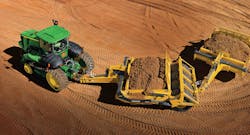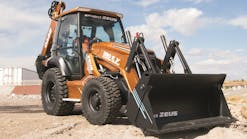“This is one of the main questions contractors have been asking themselves for years,” says Carl Seeliger, utility product manager for Astec Underground, a trencher manufacturer based in Loudon, TN. “Why should I spend more than $100,000 for a utility trencher, when I can spend two-thirds or three-fourths of that, and get a compact excavator that will dig the same trench?”
Seeliger ticks off some answers. With a trencher you get versatility-you can mount a backhoe attachment on the front of a trencher. A trencher will give you a cleaner cut, he says, with more stable sidewalls. And once you get above a 12.5- to 14-ton excavator, you have to lose the blade on the front, so you must buy another machine for backfilling. But a trencher comes with a backfill blade.
"This is one of the main questions contractors have been asking themselves for years," says Carl Seeliger, utility product manager for Astec Underground, a trencher manufacturer based in Loudon, TN. "Why should I spend more than $100,000 for a utility trencher, when I can spend two-thirds or three-fourths of that, and get a compact excavator that will dig the same trench?" Seeliger ticks off some answers. With a trencher you get versatility-you can mount a backhoe attachment on the front of a trencher. A trencher will give you a cleaner cut, he says, with more stable sidewalls. And once you get above a 12.5- to 14-ton excavator, you have to lose the blade on the front, so you must buy another machine for backfilling. But a trencher comes with a backfill blade. [text_ad] What's more, a trencher can be fitted with dirt teeth or rock teeth, and it can dig in rock. "They do make some specialized rock buckets for excavators, but if you get into really hard rock, you have to buy a breaker, and that will cost you $18,000 to $50,000," says Seeliger. "With a trencher I can easily adapt to rock with a rock chain or a rock saw. "And with a roto-boring attachment for a trencher, I can drill under a driveway or a sidewalk," Seeliger adds. "I don't have to disturb the pavement. You can't do that with an excavator." Which machine will out-produce the other? Predictably, manufacturers line up along the lines of the machines they make and sell. And of course, production depends on size. "If I take a 16-metric-ton excavator and go up against a 50-horsepower trencher, I will out-produce that trencher," says Seeliger. "But if I put the same 16-ton excavator up against a 120-horsepower trencher-say our RT 1200 trencher-I would think that 120-horsepower trencher would out-produce a 16-ton excavator. It depends on the size of the machine. "With a larger trencher you can get the same or greater production as you can with an excavator, and you have a cleaner work site," says Seeliger. "Dirt is not scattered." For some applications, moreover, a trencher can mount an integrated reel carrier to carry your product pipe. As the trencher moves ahead, pipe comes off the spool and enters the trench. "It depends on the line you're laying, but you can't do that with a compact excavator." Trencher Production "Our customers look to dig 1 to 2 miles of trench per day," says Kevin Shimp, president of Port Industries, a trencher manufacturer in Palmyra, MO. "That's one trench with one operator, opening up 10,000 feet of trench per day, whereas one excavator can open up 1,000 to 1,500 feet per day. "So our trencher will take the place of half a dozen excavator operators, plus the fuel they burn and the maintenance their machines take. And with excavators you're going to pay the same for labor to open a trench, whether you pay one guy or six guys to do it." Frequently, the sizing of the backfill material becomes an issue, says Shimp. With an excavator the material comes out in big chunks, and engineers often don't like it when big chunks, dumped back into the trench, hit the product pipe. That's one reason for a machine called a pipeline padder, which gathers fill, screens it and returns it to the trench. "With a trencher, the spoil comes out finer, and it's a lot better backfill material to put back in the trench," says Shimp. "Plus the trench bottom is very smooth. In general, a trencher gives you higher production rates at a lower cost with less labor, and you get a better trench to install the pipeline in." The Excavator's View "Excavators are faster," says Kendall Aldridge, national sales manager for IHI Compact Excavator Sales in Elizabethtown, KY. His company distributes a full line of Japanese-built compact excavators, ranging from 1 ton to 9 tons in size. "Excavators give you more production, and you have fewer moving parts to wear out than with trenchers. Trenchers are high maintenance. Chains get knocked off, and chains get broken. The dependability factor of an excavator over a trencher is far superior, bar none." If you have a skid-steer loader around-say, a Bobcat-you may only need a trencher attachment. Mike Fitzgerald, the loader product specialist at Bobcat Co., says trencher attachments are available for all Bobcat loaders. Eight models of trencher attachments range from 24 to 62 inches in digging depth, and can dig trenches from 4 to 12 inches wide. Plus, Bobcat makes various compaction attachments. Those include a 48-inch-wide drum compactor that fits on a skid loader. And, the company offers three models of plate compactors that fit on an excavator. The plate compactors range in width from 18.75 inches to 23.5 inches. The Rental Option If you want to rent a trencher, United Rentals deploys more than 400 ride-on trenchers that are part of a fluid equipment pool rather than being assigned to specific locations. Those 400-plus units serve 250 branches in 39 states and Canadian provinces. And if you expand the scope to include all trenchers, the unit count is more than 1,100 machines serving 55 states and provinces, says Dale Asplund, vice president of business services for United Rentals Inc. Asplund says the slow economy is driving smaller contractors to look for work farther and farther from their home base as larger contractors nibble at their bids. "It doesn't make sense to transport a unit like a trencher over any real distance; it's costly and can be problematic if the equipment needs service," says Asplund. "Rental is the only solution that's always local no matter how much you widen your market area." He says the majority of United Rentals' trenchers are made by the Ditch Witch organization. "If you add Vermeer, these two brands combined account for over 90% of our ride-on trencher fleet," says Asplund. "Trenchers take a beating on the job site, and they need to perform in all kinds of conditions. We spend a lot of time evaluating our suppliers, and we feel that those two brands produce the most dependable machines." Port Industries offers a lineup of four rubber-tired Hydramaxx trenchers, engineered for digging in dirt, not rock:- Model 2400, a bucket wheel trencher that digs up to 7 feet deep, typically 20 inches wide, and weighs 36,000 pounds.
- Model 2500 is a chain-type trencher that can dig up to 7 feet deep, typically 12 to 18 inches wide, and weighs about 20 tons.
- Model 2600 is a bucket wheel trencher powered by a 350-horsepower Cummins engine. It weighs about 42,000 pounds and digs up to 7 feet deep.
- Model 2700 is the largest at 46,000 pounds and is powered by a 450-horsepower John Deere engine.
What’s more, a trencher can be fitted with dirt teeth or rock teeth, and it can dig in rock. “They do make some specialized rock buckets for excavators, but if you get into really hard rock, you have to buy a breaker, and that will cost you $18,000 to $50,000,” says Seeliger. “With a trencher I can easily adapt to rock with a rock chain or a rock saw.
“And with a roto-boring attachment for a trencher, I can drill under a driveway or a sidewalk,” Seeliger adds. “I don’t have to disturb the pavement. You can’t do that with an excavator.”
Which machine will out-produce the other? Predictably, manufacturers line up along the lines of the machines they make and sell. And of course, production depends on size.
“If I take a 16-metric-ton excavator and go up against a 50-horsepower trencher, I will out-produce that trencher,” says Seeliger. “But if I put the same 16-ton excavator up against a 120-horsepower trencher-say our RT 1200 trencher-I would think that 120-horsepower trencher would out-produce a 16-ton excavator. It depends on the size of the machine.
“With a larger trencher you can get the same or greater production as you can with an excavator, and you have a cleaner work site,” says Seeliger. “Dirt is not scattered.”
For some applications, moreover, a trencher can mount an integrated reel carrier to carry your product pipe. As the trencher moves ahead, pipe comes off the spool and enters the trench. “It depends on the line you’re laying, but you can’t do that with a compact excavator.”
Trencher Production
“Our customers look to dig 1 to 2 miles of trench per day,” says Kevin Shimp, president of Port Industries, a trencher manufacturer in Palmyra, MO. “That’s one trench with one operator, opening up 10,000 feet of trench per day, whereas one excavator can open up 1,000 to 1,500 feet per day.
“So our trencher will take the place of half a dozen excavator operators, plus the fuel they burn and the maintenance their machines take. And with excavators you’re going to pay the same for labor to open a trench, whether you pay one guy or six guys to do it.”
Frequently, the sizing of the backfill material becomes an issue, says Shimp. With an excavator the material comes out in big chunks, and engineers often don’t like it when big chunks, dumped back into the trench, hit the product pipe. That’s one reason for a machine called a pipeline padder, which gathers fill, screens it and returns it to the trench.
“With a trencher, the spoil comes out finer, and it’s a lot better backfill material to put back in the trench,” says Shimp. “Plus the trench bottom is very smooth. In general, a trencher gives you higher production rates at a lower cost with less labor, and you get a better trench to install the pipeline in.”
The Excavator’s View
“Excavators are faster,” says Kendall Aldridge, national sales manager for IHI Compact Excavator Sales in Elizabethtown, KY. His company distributes a full line of Japanese-built compact excavators, ranging from 1 ton to 9 tons in size. “Excavators give you more production, and you have fewer moving parts to wear out than with trenchers. Trenchers are high maintenance. Chains get knocked off, and chains get broken. The dependability factor of an excavator over a trencher is far superior, bar none.”
If you have a skid-steer loader around-say, a Bobcat-you may only need a trencher attachment. Mike Fitzgerald, the loader product specialist at Bobcat Co., says trencher attachments are available for all Bobcat loaders. Eight models of trencher attachments range from 24 to 62 inches in digging depth, and can dig trenches from 4 to 12 inches wide.
Plus, Bobcat makes various compaction attachments. Those include a 48-inch-wide drum compactor that fits on a skid loader. And, the company offers three models of plate compactors that fit on an excavator. The plate compactors range in width from 18.75 inches to 23.5 inches.
The Rental Option
If you want to rent a trencher, United Rentals deploys more than 400 ride-on trenchers that are part of a fluid equipment pool rather than being assigned to specific locations. Those 400-plus units serve 250 branches in 39 states and Canadian provinces. And if you expand the scope to include all trenchers, the unit count is more than 1,100 machines serving 55 states and provinces, says Dale Asplund, vice president of business services for United Rentals Inc.
Asplund says the slow economy is driving smaller contractors to look for work farther and farther from their home base as larger contractors nibble at their bids. “It doesn’t make sense to transport a unit like a trencher over any real distance; it’s costly and can be problematic if the equipment needs service,” says Asplund. “Rental is the only solution that’s always local no matter how much you widen your market area.”
He says the majority of United Rentals’ trenchers are made by the Ditch Witch organization. “If you add Vermeer, these two brands combined account for over 90% of our ride-on trencher fleet,” says Asplund. “Trenchers take a beating on the job site, and they need to perform in all kinds of conditions. We spend a lot of time evaluating our suppliers, and we feel that those two brands produce the most dependable machines.”
Port Industries offers a lineup of four rubber-tired Hydramaxx trenchers, engineered for digging in dirt, not rock:
- Model 2400, a bucket wheel trencher that digs up to 7 feet deep, typically 20 inches wide, and weighs 36,000 pounds.
- Model 2500 is a chain-type trencher that can dig up to 7 feet deep, typically 12 to 18 inches wide, and weighs about 20 tons.
- Model 2600 is a bucket wheel trencher powered by a 350-horsepower Cummins engine. It weighs about 42,000 pounds and digs up to 7 feet deep.
- Model 2700 is the largest at 46,000 pounds and is powered by a 450-horsepower John Deere engine.
Other trenchers from Port Industries include the Model 2800, a steel-track machine with a 450-horsepower John Deere engine and an undercarriage the size of a Cat D6. It will trench 9 feet deep and from 32 to 46 inches wide. The Model 3600 is a self-contained plow; it does not dig a trench, but rather knifes into the ground to bury product lines.
Utility TrenchersWe asked John Kuyers, utility products segment manager at Vermeer Corp., what we should look for in a medium-sized tractor trencher. “How robust is the trencher itself?” says Kuyers. “If you are looking to dig in a lot of rocky soil, our trenchers were built and developed to handle those conditions. When you need to install a utility line in solid frost in Chicago in January, a trencher is pretty much the only piece of equipment that can do the job in those conditions.”
“The tracks will also give you an exceptional amount of stability on side hills where you may need to go through ditch lines,” he continues. “The other aspect of tracks is, they take all the bounce out of the tractor when you are trenching. When you hit rocks or roots with a rubber-tired machine, you may bounce quite a bit.
This fall, Vermeer is offering its Trench Sense system on three trencher models; it already is offered on three other models. Trench Sense is Vermeer’s automated method of controlling a trencher when it hits heavy or difficult conditions.
“Our electronic controls allow you to maximize the productivity to your trencher and ground drive,” says Kuyers. “Trench Sense reads the engine speed. If it senses an rpm drop in a particular period in time, within a split second it stops the ground drive, stops the digging chain, reverses it, backs the machine up slightly and then continues to spin the chain again. The machine will then resume the ground drive speed at its preset speed.”
Vermeer also touts the good ergonomics of its trenchers. All ride-on trenchers except the RTX450 feature a seat that pivots at a right angle from straight ahead. That way, the operator can simply look to one side to see the trencher, and look to the other side to see where he’s going.
New From Ditch Witch
Earlier this year the Ditch Witch organization announced the release of the new RT115 Quad, a heavy-duty, 115-horsepower machine designed to install utilities in extremely difficult conditions. The RT115 Quad features a ground drive system with an exclusive chevron track pattern to help provide traction on rugged terrain in muddy and wet conditions. The machine runs on four vertical track assemblies, each consisting of a triangular-shaped track with a sprocket at all three corners of the triangle.
The chevron track pattern is designed to direct mud down and to the side of the tracks as they turn, improving traction for maximum pulling power. Additionally, the track assemblies oscillate, further enhancing maneuverability on uneven terrain.
The RT115 Quad’s weight and low center of gravity increase traction and stability. The unit has one of the most heavy-duty steel undercarriages available-manufactured in-house and weighing 1,500 pounds each. These heavy-duty components provide increased drawbar pull and stability.
The fully hydrostatic RT115 Quad offers a selection of hydraulically driven rear attachments plus a choice of a front-mounted backhoe, reel carrier, or standard nose weight. The vibratory plow attachment features heavy-duty lift arms designed specifically for the RT115 Quad’s power and drawbar pull.
Compaction: the Choices
Sakai American manufactures two main trench compactors, says Shane Sirmons, operations manager for the Adairsville, GA, company. One is the SV201, a 54-inch-wide, 5-ton, single-drum vibratory machine. It’s a ride-on compactor with a special traction control system that enables it to climb out of trenches. “And the exhaust on our SV201 comes up well above the machine to keep exhaust gases out of the trenches,” says Sirmons.
The second trench roller is an 84-inch-wide model designed for larger trenches in the upper Midwest. Powered by a 148-horsepower Cummins engine, the SV510 weighs 11 tons. It also has a special traction control system designed to help the machine climb out of trenches.
“If the computer detects hydrostatic fluid flow going faster to a wheel or drum that is slipping, the computer will balance out the flow to direct more flow to the wheel or drum that is not slipping,” says Sirmons.
Trench Grader Inc. of Fair Oaks, AR, makes compaction wheels that mount onto the front of a skid-steer loader. The MP 24 is the smallest unit-for a mini-skid-steer loader-and it can apply 5,000 pounds of force.
Compaction drums range from 3 inches wide by 24 inches in diameter up to 24 inches wide and 4 feet in diameter.
The largest compaction drum from Trench Grader is the SP48A, which weighs 2,150 pounds and can apply 10,000 pounds of centrifugal force. It takes a 65-horsepower skid-steer to run it, and it can extend 38 inches down into the trench. Trench Grader’s compactors have top-mounted vibratory power units that enable the wheels to go deeper into the trench than half the diameter of the wheel.
Stanley Hydraulic Tools, Milwaukie, OR, makes a full line of plate compactors that mount onto excavators. The smallest in the HS Series is the Model 2500, which exerts 2,500 pounds of centrifugal force at a frequency of 2,100 vibrations per minute. The largest unit in the HS Series is the Model 22000, which can pump out 22,000 pounds of centrifugal force at 2,100 vibrations per minute. It requires a rated hydraulic flow of 42 gallons per minute.
If you’re in the market for a trencher or excavator, it’s best not to make up your mind before you start looking. The answer, as always, depends on your conditions, your product pipe or lines, and how fast you need to complete the job-among other factors. It’s an interesting adventure. Enjoy the journey!







